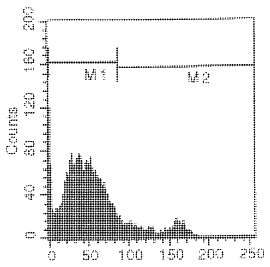Cd8a Rat Monoclonal Antibody [Clone ID: CT-CD8a]
Specifications
| Product Data | |
| Clone Name | CT-CD8a |
| Applications | FC |
| Recommended Dilution | Flow Cytometry Analysis (see Protocols). (Reported to be useful in immunohistochemistry on acetone-fixed frozen sections.) |
| Reactivities | Mouse |
| Host | Rat |
| Isotype | IgG2a |
| Clonality | Monoclonal |
| Specificity | This anti-mouse CD8a antigen monoclonal antibody recognizes the mouse CD8α chain. The α chain of CD8 associates with the CD8β chain to form a CD8α/β heterodimer that is expressed by the majority of thymocytes and by the MHC class I restricted subset of mature T cells1. Mouse CD8α can also form a CD8α/α chain homodimer on subsets of CD8 positive cells. For this reason, antibodies specific for CD8a rather than CD8b are recommended for a rigorous delineation of CD8 positive cells. |
| Formulation | PBS, 0.1% sodium azide (NaN3) and EIA grade BSA as a stabilizing protein to bring total protein concentration to 4-5 mg/ml Label: PE State: Liquid purified IgG |
| Concentration | 0.1 mg/ml |
| Conjugation | PE |
| Database Link | |
| Background | The CD8 antigen is a cell surface glycoprotein found on most cytotoxic T lymphocytes that mediates efficient cell to cell interactions within the immune system. The CD8 antigen, acting as a coreceptor, and the T cell receptor on the T lymphocyte recognize antigen displayed by an antigen presenting cell (APC) in the context of class I MHC molecules. The functional coreceptor is either a homodimer composed of two alpha chains, or a heterodimer composed of one alpha and one beta chain. Both alpha and beta chains share significant homology to immunoglobulin variable light chains. |
| Synonyms | CD8 alpha chain, CD8A, MAL |
| Note | Protocol: FLOW CYTOMETRY ANALYSIS: Method: 1. Prepare a cell suspension in media A. For cell preparations, deplete the red blood cell population with Lympholyte®-M cell separation medium. 2. Wash 2 times. 3. Resuspend the cells to a concentration of 2x10e7 cells/ml in media A. Add 50 µl of this suspension to each tube (each tube will then contain 1 x 10e6 cells, representing 1 test). 4. To each tube, add ~1.0 µg*of this Ab per 1x10e6 cells. 5. Vortex the tubes to ensure thorough mixing of antibody and cells. 6. Incubate the tubes for 30 minutes at 4°C. (It is recommended that the tubes are protected from light, since most fluorochromes are light sensitive.) 7. Wash 2 times at 4°C. 8. Resuspend the cell pellet in 50 µl ice cold media B. 9. Transfer to suitable tubes for flow cytometric analysis containing 15 µl of propidium iodide at 0.5 mg/ml in PBS. This stains dead cells by intercalating in DNA. Media: A. Phosphate buffered saline (pH 7.2) + 5% normal serum of host species + sodium azide (100 µl of 2M sodium azide in 100 mls). B. Phosphate buffered saline (pH 7.2) + 0.5% Bovine serum albumin + sodium azide (100 µl of 2M sodium azide in 100 mls). Results: Mouse Strain: BALB/c Cell Concentration: 1x10e6 cells per test Antibody Concentration Used: 1.0 µg/10e6 cells |
| Reference Data | |
Documents
| Product Manuals |
| FAQs |
| SDS |
{0} Product Review(s)
0 Product Review(s)
Submit review
Be the first one to submit a review
Product Citations
*Delivery time may vary from web posted schedule. Occasional delays may occur due to unforeseen
complexities in the preparation of your product. International customers may expect an additional 1-2 weeks
in shipping.






























































































































































































































































 Germany
Germany
 Japan
Japan
 United Kingdom
United Kingdom
 China
China



